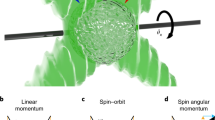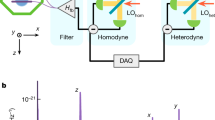Abstract
The optical torque wrench is a laser trapping technique capable of applying and directly measuring torque on microscopic birefringent particles using spin momentum transfer, and has found application in the measurement of static torsional properties of biological molecules such as single DNAs. Motivated by the potential of the optical torque wrench to access the fast rotational dynamics of biological systems, a result of its all-optical manipulation and detection, we focus on the angular dynamics of the trapped birefringent particle, demonstrating its excitability in the vicinity of a critical point. This links the optical torque wrench to nonlinear dynamical systems such as neuronal and cardiovascular tissues, nonlinear optics and chemical reactions, all of which display an excitable binary (‘all-or-none’) response to input perturbations. On the basis of this dynamical feature, we devise and implement a conceptually new sensing technique capable of detecting single perturbation events with high signal-to-noise ratio and continuously adjustable sensitivity.
This is a preview of subscription content, access via your institution
Access options
Subscribe to this journal
Receive 12 print issues and online access
$209.00 per year
only $17.42 per issue
Buy this article
- Purchase on Springer Link
- Instant access to full article PDF
Prices may be subject to local taxes which are calculated during checkout





Similar content being viewed by others
References
Neuman, K. C. & Nagy, A. Single-molecule force spectroscopy: Optical tweezers, magnetic tweezers and atomic force microscopy. Nature Methods 5, 491–505 (2008).
Bustamante, C., Macosko, J. & Wuite, G. Grabbing the cat by the tail: Manipulating molecules one by one. Nat. Rev. Mol. Cell Biol. 1, 130–136 (2000).
Funnell, B. E., Baker, T. A. & Kornberg, A. In vitro assembly of a prepriming complex at the origin of the Escherichia coli chromosome. J. Biol. Chem. 262, 10327–10334 (1987).
Liu, L. F. & Wang, J. C. Supercoiling of the DNA template during transcription. Proc. Natl Acad. Sci. USA 84, 7024–7027 (1987).
Yoshida, M., Muneyuki, E. & Hisabori, T. ATP synthase, a marvellous rotary engine of the cell. Nat. Rev. Mol. Cell Biol. 2, 669–677 (2001).
Sowa, Y. & Berry, R. M. Bacterial flagellar motor. Q. Rev. Biophys. 41, 103–132 (2008).
Friese, M. E. J., Nieminen, T. A., Heckenberg, N. & Rubinsztein-Dunlop, H. Optical alignment and spinning of laser-trapped microscopic particles. Nature 394, 348–350 (1998).
Forth, S. et al. Abrupt buckling transition observed during the plectoneme formation of individual DNA molecules. Phys. Rev. Lett. 100, 148301 (2008).
Bryant, Z. et al. Structural transitions and elasticity from torque measurements on DNA. Nature 424, 338–341 (2003).
Celedon, A. et al. Magnetic tweezers measurement of single molecule torque. Nano Lett. 9, 1720–1725 (2009).
Lipfert, J., Kerssemakers, J. W. J., Jager, T. & Dekker, N. H. Magnetic torque tweezers: Measuring torsional stiffness in DNA and RecA-DNA filaments. Nature Methods published online 10.1038/nmeth.1520, (17 October 2010).
La Porta, A. & Wang, M. D. Optical torque wrench: Angular trapping, rotation, and torque detection of quartz microparticles. Phys. Rev. Lett. 92, 190801 (2004).
Deufel, C., Forth, S., Simmons, C. R., Dejgosha, S. & Wang, M. D. Nanofabricated quartz cylinders for angular trapping: DNA supercoiling torque detection. Nature Methods 4, 223–225 (2007).
Gutierrez-Medina, B., Andreasson, J. O. L., Greenleaf, W. J., La Porta, A. & Block, S. M. An optical apparatus for rotation and trapping. Methods Enzymol. 475, 377–404 (2010).
Adler, R. A study of locking phenomena in oscillators. Proc. IRE 34, 351–357 (1946).
Izhikevich, E. M. Neural excitability, spiking and bursting. Int. J. Bifurc. Chaos 10, 1171–1266 (2000).
Hodgkin, A. L., Huxley, A. F. & Katz, B. Measurement of current–voltage relations in the membrane of the giant axon of Loligo. J. Physiol. 116, 424–448 (1952).
Rush, A. M. et al. A single sodium channel mutation produces hyper- or hypoexcitability in different types of neurons. Proc. Natl Acad. Sci. USA 103, 8245–8250 (2006).
Izhikevich, E. M. Dynamical Systems in Neuroscience (MIT Press, 2006).
Feingold, M., Gonzalez, D. L., Piro, O. & Viturro, H. Phase locking, period doubling, and chaotic phenomena in externally driven excitable systems. Phys. Rev. A 37, 4060–4063 (1988).
Glass, L., Hunter, P. & McCulloch, A. Theory of Heart: Biomechanics, Biophysics, and Nonlinear Dynamics of Cardiac Function (Springer, 1991).
Barland, S., Piro, O., Giudici, M., Tredicce, J. R. & Balle, S. Experimental evidence of van der Pol–Fitzhugh–Nagumo dynamics in semiconductor optical amplifiers. Phys. Rev. E 68, 036209 (2003).
Yacomotti, A. M. et al. Interspike time distribution in noise driven excitable systems. Phys. Rev. Lett. 83, 292–295 (1999).
Coullet, P., Gilli, J. M., Monticelli, M. & Vandenberghe, N. A damped pendulum forced with a constant torque. Am. J. Phys. 73, 1122–1128 (2005).
Epstein, I. R. & Pojman, J. A. An Introduction to Nonlinear Chemical Dynamics: Oscillations, Waves, Patterns, and Chaos (Oxford Univ. Press, 1998).
Shelton, W. A., Bonin, K. D. & Walker, T. G. Nonlinear motion of optically torqued nanorods. Phys. Rev. E 71, 036204 (2005).
Rothmayer, M., Tierney, D., Frins, E., Dultz, W. & Schmitzer, H. Irregular spin angular momentum transfer from light to small birefringent particles. Phys. Rev. A 80, 043801 (2009).
Rodriguez-Otazo, M., Augier-Calderin, A., Galaup, J-P., Lamère, J-F. & Fery-Forgues, S. High rotation speed of single molecular microcrystals in an optical trap with elliptically polarized light. Appl. Opt. 48, 2720–2730 (2009).
McNaughton, B. H., Agayan, R. R., Clarke, R., Smith, R. G. & Kopelman, R. Single bacterial cell detection with nonlinear rotational frequency shifts of driven magnetic microspheres. Appl. Phys. Lett. 91, 224105 (2007).
Helgesen, G., Pieranski, P. & Skjeltorp, A. T. Nonlinear phenomena in systems of magnetic holes. Phys. Rev. Lett. 64, 1425–1428 (1990).
Eguia, M. C. & Mindlin, G. B. Distribution of interspike times in noise-driven excitable systems. Phys. Rev. E 61, 6490–6499 (2000).
Leach, J. et al. Comparison of Faxén’s correction for a microsphere translating or rotating near a surface. Phys. Rev. E 79, 026301 (2009).
Tolić-Norrelykke, S. F. et al. Calibration of optical tweezers with positional detection in the back focal plane. Rev. Sci. Instrum. 77, 103101 (2006).
Acknowledgements
We thank A. La Porta for graciously sharing key aspects of the construction of OTW, M. Wang for discussion of polarization, E. van der Drift, M. Zuiddam, A. van Run and M. van der Krogt of the Delft Nanofacility and J. Andreasson of Stanford University for advice on the microfabrication of quartz cylinders, M. Wiggin for help in fabricating them, J. van der Does, D. de Roos and J. Beekman for help with instrumentation and infrastructure, J. Kerssemakers, I. de Vlaminck, M. van Loenhout, S. Klijnhout and J. Lipfert for stimulating discussions, and the TU Delft, FOM (Dutch Foundation for Research on Matter), NWO (Nederlandse Organisatie voor Wetenschappelijk Onderzoek) and the European Science Foundation for financial support.
Author information
Authors and Affiliations
Contributions
F.P. and Z.H. contributed equally to this work. F.P., S.B. and N.H.D. conceived and designed the experiments. F.P., M.v.O. carried out the experiments. Z.H. developed the nanofabrication protocols. F.P., Z.H., S.B. and M.v.O. analysed the data. Z.H. and S.B. contributed materials and analysis tools. F.P., Z.H., S.B. and N.H.D. wrote the paper.
Corresponding author
Ethics declarations
Competing interests
The authors declare no competing financial interests.
Supplementary information
Supplementary Information
Supplementary Information (PDF 557 kb)
Rights and permissions
About this article
Cite this article
Pedaci, F., Huang, Z., van Oene, M. et al. Excitable particles in an optical torque wrench. Nature Phys 7, 259–264 (2011). https://doi.org/10.1038/nphys1862
Received:
Accepted:
Published:
Issue Date:
DOI: https://doi.org/10.1038/nphys1862
This article is cited by
-
Data-driven reaction coordinate discovery in overdamped and non-conservative systems: application to optical matter structural isomerization
Nature Communications (2021)
-
Optical Twist Induced by Plasmonic Resonance
Scientific Reports (2016)
-
Detection of Brownian Torque in a Magnetically-Driven Rotating Microsystem
Scientific Reports (2016)
-
Local viscoelasticity of living cells measured by rotational magnetic spectroscopy
Nature Communications (2016)
-
Spike processing with a graphene excitable laser
Scientific Reports (2016)



